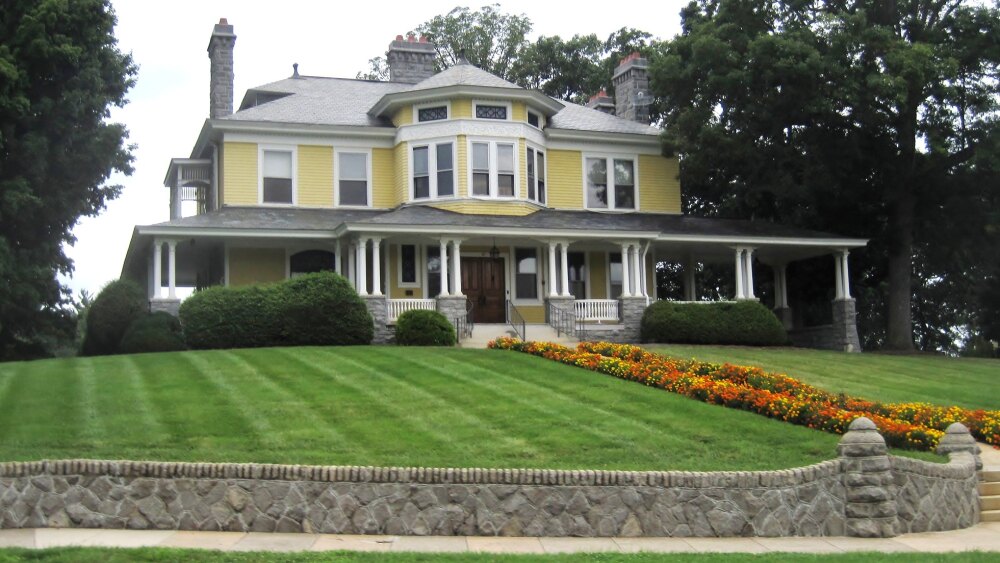On the outskirts of downtown bounded by U.S. Routes 19/23, I-240 + Broadway St. is one of Asheville’s most iconic neighborhoods – Montford. Now known for its colorful houses with wide porches, thriving restaurants + cultural scene, Montford’s 300 acres include over 600 buildings, mostly residential, all built during Asheville’s prime – between 1890 and 1925. Architect Richard Sharp Smith (supervising architect of the Biltmore House + of Biltmore Village, as well as the YMI Building downtown) created many of the homes in Montford, creating the neighborhood’s instantly recognizable aesthetic.
We’re diving into the history of Montford for this #ThrowbackThursday, so next time you wander through the tree-lined streets you can impress all of your friends with your stellar 411.
- Before Montford, there was Stumptown – a thriving African-American community bordering the area that would become Montford. The area, named for trees cleared for building houses, was once the home of 250 families. Stumptown was developed in the 1960s and 70s during urban renewal, and was mostly replaced with the Montford Community Center and a park area.
- The historic 300-acre Montford neighborhood started as an undeveloped area north of Battery Park in the late 1880s before being purchased by the Asheville Loan, Construction, and Improvement Company in 1889.
- The firm purchased, subdivided the area, and sold lots of land to several middle class individuals – a community of about 50 people. They started planning + creating infrastructure for the neighborhood, including a water and sewage system, shade tree plantings + sidewalks.
- The name “Montford” likely came from Richmond Pearson, a member of ALC&I’s board of directors. He named it after the family name of his grandmother, Elizabeth Mumford (a variation of the English name Montford). In Old French, Montford means “strong hill.”
- George Willis Pack – a.k.a. The philanthropist + benefactor of the town’s library and public square, took over the enterprise started by Asheville Loan, and he donated land for Montford Park on the end of Montford Ave. (where Shakespeare in the Park takes place today).
- Some of the larger buildings served as boarding houses, sanitariums for tuberculosis, and mental health facilities. Medical thinking at the time posited that the mountain air was good for people in need of healing – hence Montford’s early reputation as a retreat and wellness center. DYK: Tuberculosis was the leading cause of death in the U.S. at the turn of the century.
- Homes + facilities welcomed a diverse population, housing African Americans as well as whites. Early city directories indicate that there were working class citizens among the higher middle class doctors, lawyers, architects, etc.
- Montford’s famous Riverside Cemetery is the final resting place of many famous residents + visitors, including writers Thomas Wolfe, William Sydney Porter (a.k.a. O. Henry), and Zebulon Vance.
- Zelda Fitzgerald died in a fire at Montford’s Highland Hospital in 1948.
- In 1977 a large portion of the Montford neighborhood was listed in the National Register of Historic Places and in 1981 the Asheville City Council designated what is now the Montford Historic District as a local historic district.
- Montford contains more than a dozen bed and breakfasts.
Ready for your walking tour of Montford? Here are seven spots to scout out.
Highland Hospital, Zillicoa St.
Originally called “Dr. Carroll’s Sanatorium,” Highland was founded by Dr. Robert Carroll, who built Homewood (below) nearby. He created a treatment program for mental and nervous disorders and addictions based on exercise, diet, and occupational therapy that brought in patients from all over the country.
Originally downtown, Highland was relocated to Montford in 1902. On March 10, 1948, a fire broke out in the main building, taking the lives of nine women, including Zelda Fitzgerald. Though the main building is gone, several structures used by the hospital remain.
Dr. Robert Carroll came from Duke University to build Highland Hospital in 1904. In 1927, the English Stone Manor known as Homewood was built as Carroll’s private home right beside Highland Hospital. The Carrolls hosted famous people such as Zelda + F. Scott Fitzgerald and the Vanderbilts while composer Bela Bartok played Mrs. Carroll’s grand piano in the Great Room.
Today Homewood is a wedding and events venue.
The Lion and The Rose B&B, 276 Montford Ave.
Built in 1898 by a couple from Wisconsin, Elmer and Charity Rush Craig moved to Asheville to help Elmer’s deteriorating health. They built the Queen Anne, Georgian style home to be their permanent N.C. residence. In 1913 the house was purchased by the Toms family.
The character Tommy French in Thomas Wolfe’s book Look Homeward Angel was based on the Toms’ son, Charles French Toms. While a few changes have been made to the home along the years, it has been restored to its original Queen Anne state and is a bed and breakfast.
Montford Park Players at the Hazel Robinson Amphitheatre, 92 Gay St.
N.C.’s longest-running Shakespeare in the Park festival started in Montford in 1973. The first show, As You Like It, was performed at the municipal park on Montford Ave. The Montford Park Players currently perform a 20-week summer season as well as an indoor winter season.
Bonus: They’re ranked in the top four outdoor theatres in the state.
The Rankin House, 32 Elizabeth Pl.
The Rankin House is the oldest home in Montford, built in the Greek Revival style around 1846 by William Rankin, a Tennessee merchant whose son, James Eugene Rankin, was Asheville’s mayor for four terms + was an owner of the Asheville Citizen (now the Asheville Citizen-Times).
The Rankin House opened its doors as an inn in 2014. It’s now privately owned but they rent a room on VRBO.
Riverside Cemetery, 53 Birch St.
The historic cemetery includes 3.5 miles of roads on 87 acres overlooking the French Broad River. Created in and still active today, it’s the final resting place of several well-known Asheville residents + visitors and contains over 13,000 graves and 9,000 monuments. It’s open to the public for self-guided walking or driving tours and welcomes over 4,000 visitors per year.
Known as the Carriage House, this 1889 home was built for Osella B. + Leva D. Wright. It is one of Asheville’s best surviving examples of a Colonial Revival-influenced, Queen Anne-style residence. The Wrights owned a leather goods shop, the Carolina Carriage House, on Patton Ave.
In 1913, the family sold their home + property to attorney and State Senator Julius C. Martin and his wife Emily. On the same day, the Martins sold back a portion of the property to Leva. from 1914 until her death in 1945, she was the only one listed as owner. The property changed hands several times after her death before being renovated in the late 1980s for its current use as a bed and breakfast.
Put these on your iCal
Greek Festival by Holy Trinity Greek Orthodox Church of Asheville
Sept. 27-29 | Fri. + Sat. 11 a.m.-9 p.m., Sun. 11 a.m.-4 p.m. | Free
Annual Montford Holiday Tour of Homes
Sat., Dec. 7 | 1– 5 p.m. | $25 per person | Self-guided tour of 10 homes.
Montford Music + Arts Festival
Yearly each May | 10 a.m.-7 p.m. | Free
Ready to stay a while?
Check out our Montford bed and breakfast roundup here.











